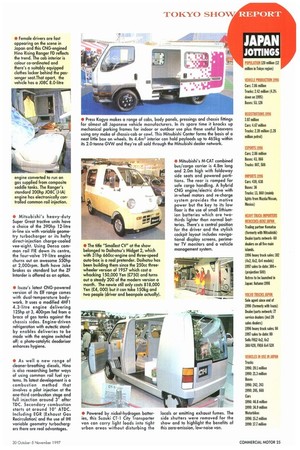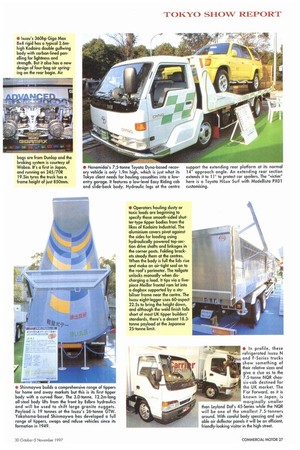Land of the rising stars
Page 26

Page 27

Page 29

Page 28

If you've noticed an error in this article please click here to report it so we can fix it.
The 32nd biennial Tokyo motor show had all the trappings of a major world auto exhibition— glitz, glamour, a glut of engineering design and innovation...and trucks with very big engines! But as Bryan Jarvis found, commercials and buses were lumped in with cars and motorcycles so there were fewer CVs and PSVs than at previous events. This could trigger a switch to the truck bodywork and trailer exhibition which is held nearby on alternate years.
More than 330 companies from 14 countries (including the UK among eight EC states) attended what was certainly the busiest Tokyo show to date, with an expected bumper crowd far in excess of 1995s 1.5-million visitors.
Seventy-million vehicles shore Japan's roads so congestion, traffic accidents, noise and air pollution are pretty much the norm. However, the world conference on global warming will be held in Kyoto in December so it was only fitting that the show focused on protection of the environment.
Japans truck manufacturers had cleaner-breathing, more fuel-efficient engines on display alongside vehicles that run on gas, electricity or a combination of the two.
The big four in Japan—Hino, Isuzu, Mitsubishi and Nissan Diesel—should be comfortable, but the recession hasn't gone away and exports are affected by overheated SE Asian tiger economies. Hino, for example, takes about 30% of its domestic market and usually exports around 15,000 vehicles to Thailand. This year it will be hard pressed to make 3,000.
Isuzu, by way of contrast, is making huge strides in Europe, and with a new engine factory due to come on stream in June 1999 it aims to become a major diesel unit producer. Its current annual engine build is 600,000 but the target is 1.6-million by 2002.
Isuzu is about to launch NQR 7.5-tanners on to the UK market, built by Leyland Trucks and ably supported by Lex Transfleet and Multipart. Larger F-Series rigids could soon follow along with its Giga tractor units.
Mercedes and Volvo are trying to redress the balance and each has established a dealer network in Japan, M-B through Komatsu with the Swedes setting up their own.
This customised Gigo Aero has isuzu`s latest 20-litre inline six rated at 520hp. With seven-speed synchromesh gearbox and electro-magnetic retarder the unit weighs in close to 7.5 tonnes but with a 600hp naturally aspirated 30.4 litre, fourbag rear air suspension, air springing on cab and driver's seat plus air bag, it's much closer to 8.0 tonnes.
• Isuzu says the Elf UT panelvan is essentially for the domestic market, but it could yet arrive on our doorstep if there's sufficient interest. It's a high-roof carrier for urban deliveries with a door in the B-post bulkhead for access to the 3.0m-long, 1.78m-high interior. With a 130hp 3.0-litre diesel, four-speed auto box and rear-wheel drive, it's rated at 4.69 tonnes GVW for Japan. Payload is 2.11 tonnes.
• Flino gains maximum volume on this Super Dolphin ProFia rigid 8x4 by using 245/70R 19.5in tyres and a short cab. At its 25-tonne GVVV limit it can carry 14.1 tonnes but there's 65m3 of load space in the 10m long body. An overall height of 3.79m allows plenty of headroom in the airconditioned cab and for overnights there's a fold-down bunk
midway up the back wall. Drivers can star-gaze via the glazed, bulging bubble roof. Upstairs there's a duplicate screen for the optional Denso Navira TV-cum-novigation system mounted on the dash, For extra safety an airbag, pre-tensioned seatbelts and collision avoidance systems are all standard, as is cruise control. • Female drivers are fast appearing on the scene in Japan and this CNG-engined Hino Rising Ranger FD reflects the trend. The cab interior is colour co-ordinated and there's a suitably equipped clothes locker behind the passenger seat.That apart, the vehicle has a JO8C 8.0-litre engine converted to run on gas supplied from composite saddle tanks. The Ranger's standard 200hp JOBC (J-IA) engine has electronically controlled common rail injection.
• Mitsubishi's heavy-duty Super Great tractive units have a choice of the 390hp 12-litre in-line six with variable geometry turbocharger or its hefty direct-injection charge-cooled vee-eight. Using Denso common rail FIE down its centre, the four-valve 19-litre engine churns out an awesome 5504 at 2,000rpm. Both have Jake brakes as standard but the ZF Intarder is offered as an option.
• lsuzu's latest CNG-powered version of its Elf range comes with dual-temperature bodywork. It uses a modified 4HF1 4.3-litre engine delivering 125hp at 3, 400rpm fed from a brace of gas tanks against the chassis sides. Engine-driven refrigeration with eutectic standby enables deliveries to be made with the engine switched off; a photo-catalytic deodoriser enhances hygiene.
• As well a new range of cleaner-breathing diesels, Hino is also researching better ways of using common rail fuel systems. Its blest development is a combustion method that involves a pilot injection at the one-third combustion stage and full injection around 30 after TDC. Secondary combustion starts at around 10° ATDC. Including EGR (Exhaust Gas Recirculation} and the use of IHI variable geometry turbochargers there are real advantages. • Press Kogyo makes a range of cabs, body panels, pressings and chassis fittings for almost all Japanese vehicle manufacturers. In its spare time it knocks up mechanical parking frames for indoor or outdoor use plus these useful boxvans using any make of chassis-cab or cowl. This Mitsubishi Canter forms the basis of a neat little box on wheels. Its 4.4m3 interior can hold payloads up to 465k9 within its 2.0-tonne GM and they're all sold through the Mitsubishi dealer network.
• The title "Smallest CV" at the show belonged to Daihatsu's Midget 2, which with 31hp 660cc-engine and three-speed auto-box is a real pretender. Daihatsu has been building them since the 250cc threewheeler version of 1957 which cost a whacking 150,000 Yen (£750) and turns out a steady 200 of the modern version a month. The newie still only costs 818,000 Yen (£4, 000) but it can take 150k9 and two people {driver and beanpole actually).
• Mitsubishi's M-CAT combined bus/cargo carrier is 4.8m long and 2.0m high with foldaway side seats and powered partitions. The rear is ramped for safe cargo handling. A hybrid CNG engine/electric drive with in-wheel motors and re-charge system provides the motive power but the key to its low floor is the use of small lithiumion batteries which are twothirds lighter than normal batteries. There's a central position for the driver and the stylish cockpit layout includes navigational display screens, perimeter TV monitors and a vehicle management system.
• Powered by nickel-hydrogen batteries, this Suzuki CT-1 City Transporter van can carry light loads into tight urban areas without disturbing the locals or emitting exhaust fumes. The side shutters were removed for the show and to highlight the benefits of this zero-emission, low-noise van.
• Isuzu's 360hp Giga Max 8x4 rigid has a typical 2.6mhigh Kodaira double gullwing body with carbon-lined panelling for lightness and strength. But it also has a new design of four-bag air springing on the rear bogie. Air bags are from Dunlop and the braking system is courtesy of Wabco. It's a first in Japan, and running on 245/70R 19.5in tyres the truck has a frame height of just 850mm. • Hanarnidai's 7.5-tonne Toyota Dyna-based recovery vehicle is only 1.9m high, which is just what its Tokyo client needs for hauling casualties into a lowentry garage. It features a low-level Easy Riding cab and slide-back body. Hydraulic legs at the centre support the extending rear platform at its normal 14' approach angle. An extending rear section extends it to 11° to protect car spoilers. The "victim" here is a Toyota HiLux Surf with Modellista PX01 customising.
• Operators hauling dusty or toxic loads are beginning to specify these smooth-sided shutter-type tipper bodies from the likes of Kodaira Industrial. The aluminium covers pivot against the sides for loading using hydraulically powered top-section drive shafts and linkages in the corner posts. Folding brackets steady them at the centres. When the body is full the lids rise and make an air-tight seal on to the roof's perimeter. The tailgate unlocks manually when discharging a load. It tips via a fivepiece Meiller frontal ram let into a dogbox supported by a stabiliser frame near the centre. The Isuzu eight-legger uses 60-aspect 22.5s to bring the height down, and although the weld finish falls short of most UK tipper builders' standards, there's a decent 18.3tonne payload at the Japanese 25-tonne limit. • Toyota recently introduced this low-cabbed Dyno and of the 200 registered so far, Coca-Cola has taken the most. To bring the cab down, the chassis frame has an outrigger extension enabling it to perch ahead of the bulky 168hp 4.1-litre 15BF diesel engine. Shapely wheel arch fairings provide an extra long step and although the body front needs a small recess to clear the engine the 6.0-tonne GVW truck can carry hefty unit loads into restrictive areas.
• This Nissan Big Thumb 6x2 rigid boasts air suspension on all three axles with disc brakes on the front axles. With low-aspect 285/60R 22.5s ii squeezes a useful body volume into the 3.65m height limit. A short day cab makes room for a 9.6m-long floor in the gullwing body. Safety was a theme of the Nissan exhibits, with features such as a frontal radar warning device, air bags, side-door protection, seatbelt pre-tensioners and discharge headlamps. • Well, someone has to deliver girly garments, dry cleaning or even house plants in Tokyo! and Daihatsu's sophisticated Akindo looks to have all the necessary credentials for this role. Direct access through to the rear and a lifting gullwing side entry door makes for easy loading and unloading while the navigation system, mobile computer and cell-phone helps to serve the customer. For convenience there's a column gear shift, floor-pedal parking brake and a passenger seat that folds into a table. A 55hp three-cylinder 989cc DOHC engine provides the motive power. • Shinmaywa builds a comprehensive range of tippers for home and away markets but this is its first tipper body with a curved floor. The 3.0-tonne, 12.2m-long all-steel body lifts from the front by Edbro hydraulics and will be used to shift large granite nuggets. Payload is 19 tonnes at the Isuzu's 26-tonne GTW. Yokohama-based Shinmaywa has developed a full range of tippers, swaps and refuse vehicles since its formation in 1949.
• In profile, these —.7:141/111 reze=,,, refrigerated Isuzu N and F-Series trucks show something of their relative sizes and give a clue as to the 7.5-tonne NOR chassis-cab destined for the UK market. The F'or Forward, as it is known in Japan, is marginally smaller Leyland Daf's 45-Series while the NQR be one of the smallest 7.5-tonners around, With careful body speccing and suitable air deflector panels it will be an efficient, friendly-looking visitor in the high street.












































































































